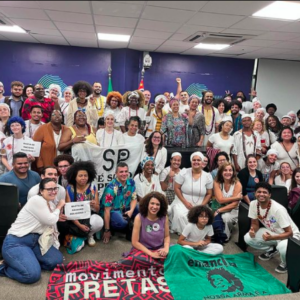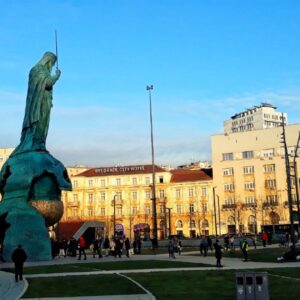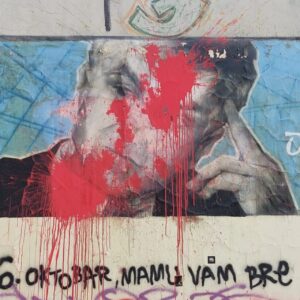

A Good Neighbour and a Good Ally? The Problem of Berlin’s Soviet War Memorials
By Abigail Osbourne •
The largest Red Army memorial in the world stands 12 metres high at the centre of a popular city park. It includes Soviet flags carved in red granite, sixteen sarcophagi representing each of the Soviet Republics, and a quotation from Stalin declaring that ‘all now recognise that the Soviet people with their selfless fight saved the civilisation of Europe from fascist thugs.’ But it is not in Russia. It is in Berlin.
Since the fall of communism, the number of Soviet-era era monuments in Central and Eastern Europe has dwindled year-on-year. But while most countries remove communist symbols from their public spaces, Germany has protected and maintained over 4000 Soviet war memorials. Today, Germany is second only to Russia in its number of Red Army memorials, including one just metres from the Bundestag.
Until recently, Germany’s Soviet war memorials had attracted little public discussion, fitting in with the country’s remembrance culture and protected by international agreements. However, since the start of the war in Ukraine, such monuments, particularly the two largest in Berlin, have become the subject of a public debate about balancing honouring the past and respecting contemporary victims of war.
Soviet War Memorials in Germany
Most of Germany’s Soviet war memorials were built in former East Germany in the aftermath of World War II to honour fallen Red Army soldiers and symbolise the ideological superiority of communism over Nazism. Often directly replacing monuments built by the Third Reich, the influx of Soviet war memorials sent a clear message to the German people that their country was under new management. Whether the monument’s design was harsh and imposing or depicted the USSR as a benevolent protector, the intention was as ideological as it was mnemonic.
With the fall of communism in the 80s and 90s, statues, monuments and other symbols of the old regime began to be erased from public spaces across the former Eastern bloc. In the newly reunified Germany, most statues of Lenin, Karl Marx and other Socialist figures were removed or repurposed without fanfare. In 1991, a Berlin Senate initiative to re-evaluate street names and monuments honouring totalitarian regimes removed most references to communism from the former East’s public spaces.
In 1996, the Bundestag began drawing up plans to remove ‘the worst excesses’ of communist ideology from the Tiergarten and Treptower Parks, Germany’s two largest Red Army memorials. Despite lengthy conversations on the topic, neither park was renovated. Two years later, the government signed the ‘Good Neighbour Agreement’ with Russia, committing both countries to protect the other’s burial grounds. This scuppered plans to renovate Tiergarten and Treptower, as both memorial parks are burial grounds for Red Army soldiers killed in the Battle of Berlin.
Cultures of Remembrance
In the two decades following the fall of the Berlin Wall, most Central and Eastern European countries removed many of their Soviet war memorials, often replacing them with new monuments to victims of communism. Hungary was the first to remove all communist symbols from its public spaces systematically. Hungary’s most prolific Red Army memorials found a new home in Budapest’s Memento Park, referred to as ‘The Endless Parade of Liberation Monuments.’
In a newly reunified Germany, Soviet statues and war memorials were largely seen as existing in two separate categories. Most communist-era statues were removed as part of efforts to integrate the former East Germany into the democratic Federal Republic. On the other hand, war memorials were protected not only by Germany’s commitment to Russia but also by the country’s ‘Culture of Remembrance.’ In Germany, there is a widespread acknowledgement that it is the citizens’ duty to remember and learn from their nation’s dark past in World War II. Germany’s Soviet Memorials fit into this culture as monuments to victims of national socialism, representing soldiers who died in the fight against Nazism and the 7 million Soviet civilians who perished in the war. Though initially erected to display the ideological superiority of communism, they have taken on a new meaning as part of ‘Erinnerungskultur.’
The trend of removing Soviet war memorials accelerated after the Russian annexation of Crimea in 2014, as monuments honouring the Red Army became associated with the new era of aggressive Russian militarism. In 2015, city authorities in Nowa Sol, Poland, removed the brotherhood-in-arms of Polish and Red Army soldiers memorial, despite threats from the Russian Embassy that this was against a 1994 monument protection agreement between Russia and Poland.
The War in Ukraine
Serious debate around the future of Germany’s Red Army memorials began when Putin launched a full-scale invasion of Ukraine in February 2022. A few weeks after the attack, Ukrainian flags were draped over the T-34 Tanks at the entrance to the Tiergarten memorial. Though the police swiftly removed these, they sparked discussion in the Bundestag. The CDU’s Stefanie Bung called for the tanks to be removed, saying, ‘Today the tank in Tiergarten no longer stands for the liberation of Germany from Nazi fascism, but for the aggressive, territorial warfare that disregards human life.’ Though other members of parliament supported her, the proposal was rejected by the Berlin Senate, who said that their hands were tied by the ‘Good Neighbour Agreement.’
In April 2022, the war memorial in Treptower Park was graffitied with anti-Russian slogans, including ‘Putin = Stalin’ and ‘Ukrainian blood on Russian Hands.’ A few days later, pro-Russian graffiti also emerged on the monument. The memorial was promptly cleaned, and security at the park was increased to avoid further vandalism.
Liberation and Victory Day
The Tiergarten and Treptower memorials erupted into national news as a site of contestation on Liberation and Victory Day 2022. Every year, on the 8th and 9th of May, both Berlin memorials host official commemorative services attended by members of the German government, the Berlin senate and the Russian embassy. 2022 Liberation Day saw Berlin’s memorial parks beset by protest and mnemonic conflict. Competing narratives of past and present wars were displayed as pro-Russian and pro-Ukrainian protestors lined the streets waving flags and banners.
On both sides of the protest, the Soviet war memorials stood as symbols for different interpretations of the past and present. For the pro-Russian protesters, who largely echoed Putin’s narrative of the ‘special military operation’ as an extension of the fight against Nazism, contemporary Russian soldiers had picked up the fight where the Red Army had left it. Thus, the monument stood to honour the fallen soldiers of the past and their ideological successors currently fighting for Russia in Ukraine. On the pro-Ukrainian side, protestors argued that the Red Army memorial honoured the ideology of Russian militarism, something that should not be accepted in Germany’s public spaces. Many voices on this side called for the memorial parks to be closed, renovated or demolished.
That is not to say that Berlin’s Ukrainian community was united in a desire to see the memorials removed. Other Ukrainian voices called for the monument recontextualisation to dispel the myth that Russia, rather than the Soviet Union as a whole, liberated Germany. Many activists from Ukraine and other post-Soviet states were glad to see the memorial service go ahead among a sea of Ukrainian flags as a reminder that every Soviet republic played a part in ending World War II.
Given the events of Victory Day in 2022, as the same event approached in 2023, city authorities were keen to stay ahead of possible unrest at the memorial services. In late April, the Berlin police banned Russian and Ukrainian flags, military uniforms and marching songs. They made it clear that they would have little tolerance for anyone who appeared to be condoning or glorifying the war in Ukraine. Ultimately, only Russian flags were banned after an outcry from anti-war activists. As the events took place, police stood at the entrance of the two memorial sites to check people’s bags and confiscate prohibited items. In one case, a man turned away from Tiergarten with a Yugoslav flag as the police ruled it could look like a Russian flag from a distance. Just like the previous year, the memorial service was beset by protests against the Russian invasion of Ukraine, and the perceived monuments to Russian militarism still stand in Berlin’s city parks.
The Future of Germany’s Soviet War Memorials
Though Germany’s Soviet war memorials largely escaped public debate in the years following the reunification, they have become increasingly controversial since the start of the war in Ukraine. The memorials at Treptower and Tiergarten Park are deeply symbolic of Germany’s Culture of Remembrance, but their presence in the city has taken on a new meaning since 2022. Painted with opposing narratives of past and present conflicts, the city police have avoided public unrest in the memorial parks during and outside official events. Though the Berlin Senate says that the memorials can’t be removed due to the ‘Good Neighbour Agreement,’ there have been suggestions to renovate the parks to avoid glorifying Russian militarism. In particular, removing the tanks and guns from the Tiergarten Memorial Park has found support among government officials, Berlin residents and members of the Ukrainian community.
In the former East German city of Dresden, similar discussions could provide the Berlin Senate with ideas about the future of the Tiergarten and Treptower memorials. The city’s cultural committee has expressed an interest in moving the tank at the Soviet Garrison Cemetery to the local war museum and ‘contextualising’ the city’s Red Army memorial since it cannot legally be removed. The Cultural Mayor has called for an information board or QR code to be installed, offering background on the origins of the memorial and the city’s history under the GDR. She explained that this way, the city could attempt to neutralise the narrative of a memorial, even when certain groups were exploiting it.
As Berlin grapples with how to address a balance between honouring victims of WWII and condemning the war in Ukraine, the future of the city’s Soviet war memorials looks uncertain. Though Germany’s international commitments make it harder to remove communist-era monuments than in other former Eastern-bloc countries, it seems the city has some options to minimise the contemporary symbolism of these sites. While they are important to Germany’s culture of remembrance, there is growing public sentiment for the site to be renovated rather than maintained.



